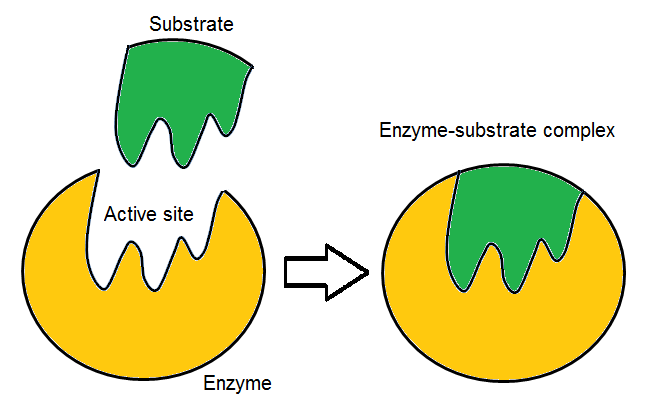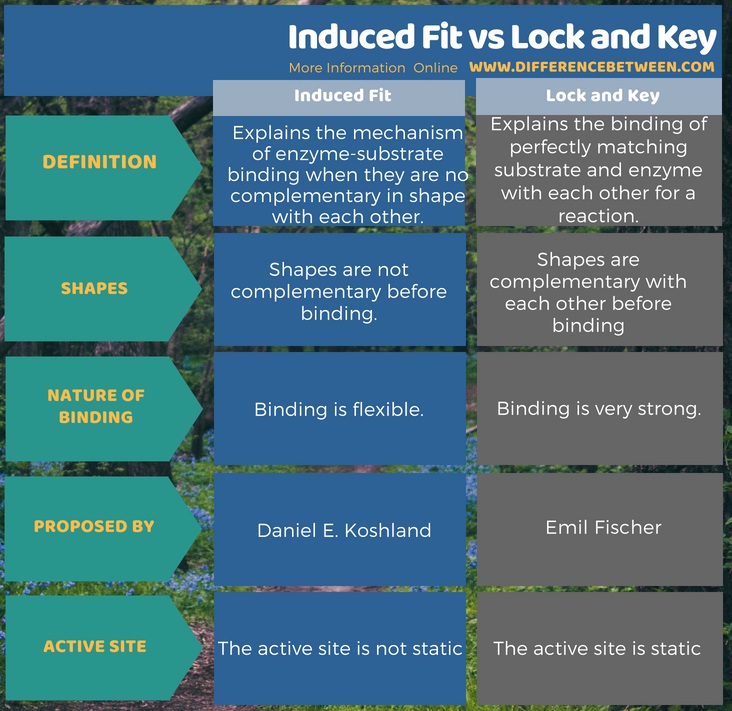Difference Between Induced Fit and Lock and Key
The key difference between Induced Fit and Lock and Key is that in induced fit theory, the binding of the substrate with the active site of the enzyme induces the modification of the shape of the active site into the complementary shape of the substrate. Whereas, in the lock and key theory, the substrate and the active site of the enzyme are complementary in shape at the beginning.
Enzymes are catalysts of metabolic reactions. Therefore, they are specific for their substrates. The substrate binds with the active site of the enzyme and then converts into the product. Two hypothesis namely, Induced Fit hypothesis and Lock and Key hypothesis explains this binding of the substrate into the enzyme.
CONTENTS
1. Overview and Key Difference
2. What is Induced Fit
3. What is Lock and Key
4. Similarities Between Induced Fit and Lock and Key
5. Side by Side Comparison – Induced Fit vs Lock and Key in Tabular Form
6. Summary
What is Induced Fit?
The induced fit is a theory that explains the binding of a substrate into an active site of an enzyme that does not have a correct conformation with that of the active site. According to this theory, confirmation of the active site modifies into a correct shape when the substrate binds.

Figure 01: Induced Fit Theory
The binding of the substrate induces the modification of the shape of the active site. Hence, the name ‘Induced fit’ is given to this hypothesis. Daniel E Koshland proposed this theory in 1959. The active site of the enzyme is not static according to this theory.
What is Lock and Key?
Lock and Key is one of the theories that explain the mode of action of an enzyme which catalyzes a reaction. Emil Fischer proposed this theory in 1894. According to lock and key hypothesis, the binding of the substrate into an active site of an enzyme is equalized into the lock and key mechanism.

Figure 02: Lock and Key Hypothesis
The particular lock can be open using the correct key. Similarly, if the enzyme is the lock, it will be open only by the correct substrate which is the key. Both fit with each other correctly and tightly. Their shapes are complementary with each other. Hence, this binding is very specific and cannot be easily broken.
What are the Similarities Between Induced Fit and Lock and Key?
- Both theories explain the action mode of an enzyme.
- They are really important to understand the binding of the substrate into an active site of an enzyme.
What is the Difference Between Induced Fit and Lock and Key?
Induced fit and lock and key are two theories that explain the mode of an enzyme. The induced fit theory describes the binding of an enzyme and substrate that are not complementary while lock and key describe the binding of enzyme and substrate that are complementary. The active site is not static in the induced fit model while it is static in lock and key model. The following infographic presents the difference between Induced Fit and Lock and Key in a tabular form.

Summary – Induced Fit vs Lock and Key
The induced fit theory explains the binding of enzyme and substrate when they are not perfectly matched with each other by their shapes. The binding of substrate induces the conformation change of the active site of the enzyme for correct binding. On the other hand lock and key theory explains the binding of perfectly matching or fitting substrate and enzyme. Similar to a ‘lock and key’, substrate and enzyme fit with each other very tightly according to this hypothesis. In the induced fit theory, the active site of the enzyme is not static while it is static in the lock and key mechanism. This is the difference between induced fit and lock and key.
Reference:
1.“Lock-and-Key Mechanism.” Gale Library of Daily Life: Slavery in America, Encyclopedia.com, 2018. Available here
2.“LOCK & KEY THEORY • A* Biology.” A* Biology. Available here
Image Courtesy:
1.’Induced fit diagram’By Created by TimVickers, vectorized by Fvasconcellos (Public Domain) via Commons Wikimedia
2.’Lock and key’By Hottuna080 (CC BY-SA 3.0) via Commons Wikimedia
ncG1vNJzZmivp6x7pbXFn5yrnZ6YsqOx07CcnqZemLyue8OinZ%2Bdopq7pLGMm5ytr5Wau261zZ2snJ2UYrOqwIyapZ1lnKSwrHnAp5tmo5WufA%3D%3D